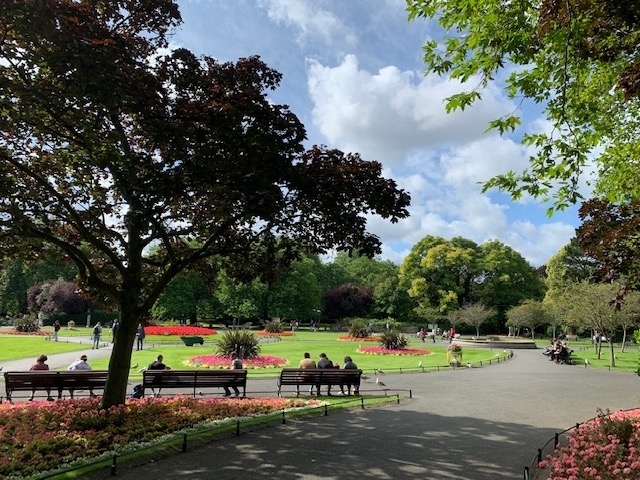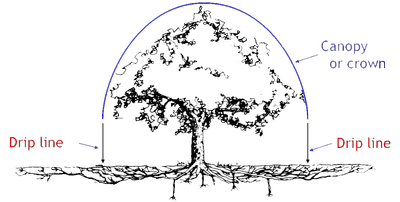Posts Tagged: drought and trees
'Trees for Tomorrow Start Today' Workshop (via Zoom) March 9, 2021 (8:15 AM - 3:00 PM)
Landscape trees provide shade, cool urban heat islands, reduce interior energy use and related costs, provide habitat for pollinators and wildlife, and beautify our communities. They also help clean our environment by absorbing carbon dioxide emitted by vehicles and other producers of fossil fuels.
Taking care of our urban trees is an important way to maximize these benefits. Unfortunately, their average lifespan in our cities is less than 1/4 of their potential due to poor selection and care. You can help enact change and increase the health, longevity and canopy coverage of our urban forests by encouraging your city leaders, local non-profit organizations interested in ‘green cities' arborists, landscape architects, nursery growers, HOAs, and concerned citizens to register for our free ‘Trees for Tomorrow Start Today' workshop (via Zoom) on Tuesday, March 9, 2021 (8:15am – 3pm).
Please reach out to your city leaders and local ‘green industry' professionals to encourage their attendance and participation. While the workshop is free, registration is required through this secure link: http://ucanr.edu/u.cfm?id=264
A bevy of speakers including certified arborists, horticulturists, planners, water district personnel and other non-profit and green industry representatives will discuss the benefits of urban trees; recommended practices for their selection and care; how to avoid hazardous trees that damage property and structures; and share success stories resulting from partnerships through cities, non-profit organizations, the green industry, HOAs, and street tree committees.
A highlight of the workshop will be the opportunity for attendees to participate in breakout sessions that cut across professions and interest groups (city planners, community service directors, arborists, landscape architects, landscapers, water district managers, HOA managers, golf course superintendents, nursery growers, UC master gardeners, concerned citizens, etc.) to enact positive change regarding tree selection and care.
Thank you for sharing this opportunity to help ensure a healthy future for our children's children with your city leaders and decision-makers.
In the meantime, here are some tree care tips to ‘start the conversation' between now and the workshop:
• Select trees that perform well in your climate. The Sunset Western Climate Zone maps are more precise than USDA zones for our warmer climates. Trees should also be selected based on their adaptation to the ‘micro-climate' in each particular landscape, as well (shade, proximity to buildings, space needs below as well as above ground, soil type, water source, etc.)
• Plant trees the same depth they were in their container in holes at least 2-1/2 times wider. Do not add compost or organic matter to the hole. This practice can result in circled roots that never grow laterally out of the confines of the dug hole.
• Remove any tree ties that are cutting into the trunk or branches of your trees. If trees must be staked due to windy conditions, make sure that the ties are loose enough to allow trees to gently flex in the wind. This helps trees develop the necessary lower trunk strength and stability to support the tree as it matures. Over time, you may be able to completely remove the ties and stakes once the lower trunk becomes stronger and self-supporting.
• Keep all plants and mulch several inches away from tree trunks.
• Keep tree trunks dry. They should not come into contact with water from sprinklers or hoses.
• Regularly water newly planted trees but water mature trees infrequently and deeply. Watering too often reduces the level of oxygen in the rootzone and can lead to waterlogged soils prone to crown and root rots. During fall, trees require only about 15% of the water they require in the summer.
• Prune trees only as needed and avoid topping them. Invest in the services of a credentialed and knowledgeable professional to correctly care for your valued trees. Find a list of International Society of Arboriculture Certified Arborists in your area here: https://www.treesaregood.org/findanarborist.
Drought Update........How to Save Your Plants Under Drought and Water Restrictions......and Use Graywater!
California is in the midst of the worst drought in decades. But you can save your valued trees and landscape plants by following a few simple principles. Watering mature trees deeply just once during mid-summer will keep most species alive, especially if there is a three inch layer of mulch on the top of the soil to keep evaporation down. Be sure to water outward toward the dripline of the tree rather than near the trunk. Keep weeds out of your garden; they will win the water fight. Don't fertilize your landscape during the drought and avoid ripping out your current landscape in the middle of summer to replace it with a drought tolerant one; young plants require more water than established landscapes, and more frequent irrigations. For more information on how to reduce water use in your landscape and garden and to learn more about using graywater from your washing machine to irrigate your landscape click on this link. http://cesanbernardino.ucanr.edu/Drought_Resources/ Janet Hartin, Environmental Horticulture Advisor, University of California ANR Cooperative Extension, San Bernardino, Riverside, and Los Angeles Counties.
Save Trees during Drought with New Tree Ring Irrigation Contraption (TRIC)
From a majestic oak, giant sequoias or a swaying palm there is nothing quite as beautiful in this world than a tree. They can provide us with shade, fruit, flowers and most importantly are the “lungs of planet”. While we have enjoyed some wet weather over the last week, California is still suffering from extreme drought conditions.
Prioritizing Trees for Landscape Water Use
Many residents have been encouraged to reduce water use by turning off their outdoor watering systems, but this may be causing stress to established trees that are becoming increasingly thirsty for water.
In most traditional residential landscapes trees are surrounded by turfgrass. Turfgrass surrounded trees take advantage of the frequent and shallow watering schedule, typically set to help the lawn flourish. When residents eliminate or reduce water for lawns, trees cannot easily adapt to the new water shortage.
“Mature fruit trees and landscape trees are worth saving! Recognizing early signs of drought stress is important because irreversible damage can occur that no amount of watering will correct.” said Janet Hartin, UC Cooperative Extension advisor in a recent article, Save Water, But Also Save Trees During a Drought.
Replacing small plants, lawns and shrubs is easy compared to a large tree which takes years to become established. Saving mature trees during a drought should be a top priority in your landscape water use allocation.
“Two seasons without enough water can result in severe drought stress and even kill a tree,” warned Hartin. “Also, drought-stressed trees are more prone to damage from diseases and insects than non-stressed trees.”
Understanding how to water a tree effectively is important to avoid water waste and to ensure that the tree is receiving the correct amount of water for its survival.
One key factor to successfully watering a tree is understanding what soil type is present. Understanding soil types is an important factor in determining how much water is stored in the ground. For example, sandy soils dry out quickly while clay soils retain more water. Contact your local UC Master Gardener Program to learn how to determine your soil type.
Tree Ring Irrigation Contraption (TRIC)
Recently the Calif. Center for Urban Horticulture (CCUH) at UC Davis, UC Division of Agriculture and Natural Resources (ANR) and Ewing Irrigation devised a unique watering system called the Tree Ring Irrigation Contraption (TRIC). Using previous data from Netafim drip tube tables and from the Irrigation Association Landscape Irrigation Auditor manual, the partners envisioned a possible solution to mitigating drought conditions and the effect on landscape trees. The TRIC is an inexpensive kit that homeowners can put together for around $100 for one large tree.
The TRIC could enable homeowners to adequately water trees to a depth of three feet with confidence, by using the recommended parts and using the TRIC calculator with accurate information. Aside from a recommended parts list, there is a “plug-in” calculator created by Dr. Loren Oki, UC ANR Associate Specialist in Cooperative Extension Landscape Horticulture for UC Davis & UC ANR. The TRIC calculator helps determine the run-time needed for the device.
Learn more by visiting:
- CCUH – Tree Ring Irrigation Contraption website
- TRIC Parts List
- TRIC Calculator
- TRIC PowerPoint Presentation







